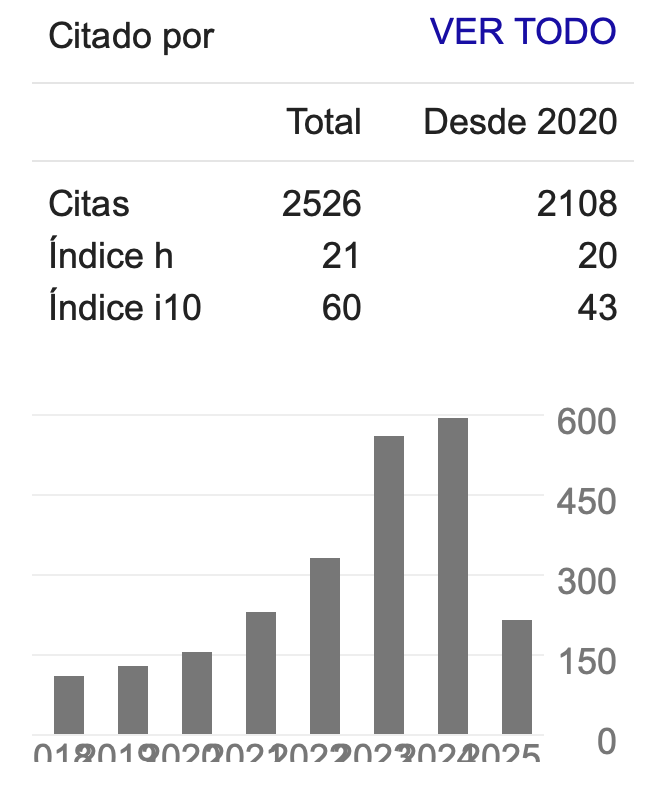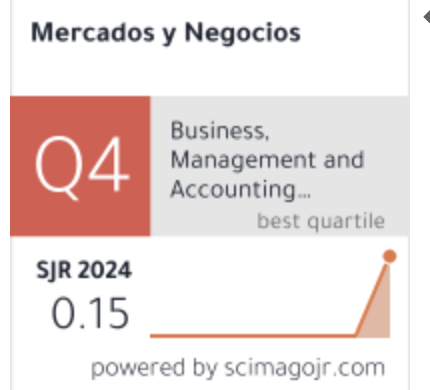Banking innovations and their effect on profitability.
DOI:
https://doi.org/10.32870/myn.vi47.7680Keywords:
Innovación, Rentabilidad, Banca sin sucursales, AdopciónAbstract
This research seeks to answer these questions by analyzing multiple empirical articles carried out at different times, in different countries, and with various innovations. The research is divided into three sections: first, it presents a chronology of the evolution of banks, their main innovations, and events that have modified the banking business model to adapt it to banking today. The second is based on bibliometric tools to present the primary references of the articles that analyze the relationship between innovation and bank profitability and its conceptual structure. Finally, the third section analyzes the concept of branchless banking and its factors. Three findings stand out: 1) according to the empirical literature consulted, it is concluded that innovation does affect profitability, 2) publications have grown in recent years, with China being the most productive country and the United States the most influential, and 3) The concept of branchless banking is a viable alternative to measure innovation in the Mexican banking sector.References
Acosta, M. (2000). La tarjeta de crédito bancaria. In Un Nuevo Derecho Bancario (pp. 583–607). Mexico: Porrúa
Adrianzen, C. (2016). La Rentabilidad de los Bancos Comerciales y el Ambiente Macroeconómico: El caso Peruano en el período 1982-2014. Doctoral dissertation, Universitat Politècnica de Catalunya.
Alvarez, J. (1993). La banca española Actualidad y perspectivas. Papeles de la Economía Española, 54, 127–138.
Amin, A., Arefin, S., Sultana, N., Islam, R., Jahan, I., & Akhtar, A. (2020). Evaluating the customers’ dining attitudes, e-satisfaction, and continuance intention toward mobile food ordering apps (MFOAs): evidence from Bangladesh. European Journal of Management and Business Economics, 30(2), 211–229. https://doi.org/10.1108/EJMBE-04-2020-0066
Aparicio, A. (2014). Historia Económica Mundial 1950–1990. Economía Informa, 385, 70–83. https://doi.org/10.1016/s0185-0849(14)70420-7
Arif, M. & Cahyani, U. (2021). Branchless banking and profitability in the Indonesian Islamic banking industry. Jurnal Ekonomi & Keuangan Islam, 7(2), 154–160. https://doi.org/10.20885/jeki.vol7.iss2.art4
Avendaño, O. (2018). Los retos de la banca digital en México. Revista del Instituto de Ciencias Jurídicas de Puebla, 12(41), 87–108.
Batiz-Lazo, B. (2009). Emergence and evolution of proprietary ATM networks in the UK. Business History, 5(1), 1–27. http:///doi/abs/10.1080/00076790802602164
Berger, A. (2003). The Economic Effects of Technological Progress: Evidence from the Banking Industry. Journal of Money, Credit, and Banking, 35(2), 141–176. https://doi.org/10.1353/mcb.2003.0009
Bordo, M., & James, H. (2011). La Gran Depresión y la Gran Recesión: ¿qué hemos aprendido? In Martín-Aceña, P. (Ed.), Pasado y Presente de la Gran Depresión del siglo XX a la Gran Recesión del siglo XXI. (pp. 113–139). BBVA Foundation.
Brown, I., Cajee, Z., Davies, D., & Stroebel, S. (2003). Cell phone banking: Predictors of adoption in South Africa - An exploratory study. International Journal of Information Management, 23(5), 381–394. https://doi.org/10.1016/S0268-4012(03)00065-3
Bueno, E., Longo, M., Salmador, M., & Morcillo, P. (2017). La Innovación del Modelo de Negocio Bancario: El Reto de la Banca Digital. AECA: Revista de la Asociación Española de Contabilidad y Administración de Empresas, 120(3–6), 1–28.
Chan, S., & Lu, M. (2011). Understanding Internet Banking Adoption and Use Behavior. Advanced Topics in Global Information Management, 5, 12(3), 21–43. https://doi.org/10.4018/9781591409236.ch014.ch000
Chipeta, C., & Muthinja, M. (2018). Financial innovations and bank performance in Kenya: Evidence from branchless banking models. South African Journal of Economic and Management Sciences, 21(1), 1–11. https://doi.org/10.4102/sajems.v21i1.1681
Clemons, E. (1990). MAC-Philadelphia national bank’s strategic venture in shared ATM networks. Journal of Management Information Systems, 7(1), 5–25. https://doi.org/10.1080/07421222.1990.11517878
CNBV. (2021). Base de datos de acceso público, ENIF 2021. Mexico: CNBV.
Colombo, M., & Grilli, L. (2007). Funding gaps? Access to bank loans by high-tech start-ups. Small Business Economics, 29(1–2), 25–46. https://doi.org/10.1007/s11187-005-4067-0
De Olloqui, J. (1984). Un enfoque bancario sobre la crisis mexicana de pagos en 1982 El Trimestre Económico, 51(203(3)), 527–544.
Dedeh Sri Sudaryanti, Nana Sahroni, A. (2018). Análisis del efecto de la banca móvil en el desempeño de las empresas del sector bancario cotizadas en la bolsa de valores de Indonesia. Journal Ekonomi Manajemen, 4(2). https://doi.org/10.37058/jem.v4i2.699
Del Ángel, G. (2019). Banco Nacional de México y la innovación en los servicios bancarios. Publicaciones Internacionales.
Dietrich, A., & Wanzenried, G. (2011). Determinants of bank profitability before and during the crisis: Evidence from Switzerland. Journal of International Financial Markets, Institutions and Money, 21(3), 307–327. https://doi.org/10.1016/j.intfin.2010.11.002
Diniz, E., Birochi, R., & Pozzebon, M. (2012). Triggers and barriers to financial inclusion: The use of ICT-based branchless banking in an Amazon county. Electronic Commerce Research and Applications, 11(5), 484–494. https://doi.org/10.1016/j.elerap.2011.07.006
Dong, J., Yin, L., Liu, X., Hu, M., Li, X., & Liu, L. (2020). Impact of internet finance on the performance of commercial banks in China. International Review of Financial Analysis, 72, 1–12. https://doi.org/10.1016/j.irfa.2020.101579
Dzombo, G., Kilika, J., & Maingi, J. (2017). The Effect of Branchless Banking Strategy on the Financial Performance of Commercial Banks in Kenya. International Journal of Financial Research, 8(4), 167. https://doi.org/10.5430/ijfr.v8n4p167
INEGI. (2021). Encuesta Nacional sobre Disponibilidad de Tecnologías de la Información en los Hogares (ENDUTIH) 2020. Mexico: INEGI.
Ferguson, N. (2008). The Ascient of Money. PBS NewsHour. Link: https://www.pbs.org/video/the-ascent-of-money-part-1-from-bullion-to-bubbles/
Flóres, L. (2008). Evolución de la Teoría Financiera en el Siglo XX. Ecos de Economía, 12(27), 145–168.
Gichungu, Z., & Oloko, A. (2015). Relationship between derivatives and financial performance of commercial banks in Kenya. International Journal of Education and Research, 3(5), 443.
Guerra, M. (2002). Breve reseña histórica del surgimiento de la banca. Economía-UNAM, 21. Link: http://www.economia.unam.mx/secss/
Gutiérrez, I. (2020). Influencing Factors of Mobile Banking Applications Adoption. Universidad de Lisboa.
Gutíerrez, I. (2019). Historia del Crédito. Muy Financiero. Link: http://www.muyfinanciero.com/historia
Han, J., & Jun, M. (2021). The impact of accessibility of mobile devices on the intention to post online reviews. European Journal of Management and Business Economics, 30(3), 386–398. https://doi.org/10.1108/EJMBE-07-2020-0185
Igual, D. (2018). Las Fintech. Oikonomics, Revista de Los Estudios de Economía y Empresa, 10, 22–44.
Irura, N. S., & Munjiru, M. M. (2013). Technology Adoption and the Banking Agency in Rural Kenya. Journal of Sociological Research, 4(1), 249–266.
Itah, A., & Emmanuel, E. (2014). Impact of Cashless Banking on Banks’ Profitability (Evidence from Nigeria). Asian Journal of Finance & Accounting, 6(2), 301. https://doi.org/10.5296/ajfa.v6i2.6268
Ivatury, G., & Mas, I. (2008). The Early Experience with Branchless Banking. CGAP Focus Note, 40, 1–16.
Jácome, H. (2002). Análisis comparativo de la regulación financiera en el sector bancario europeo y americano durante el siglo XX. Documento de Trabajo, 2, 201
Jebarajakirthy, C., & Shankar, A. (2021). Impact of online convenience on mobile banking adoption intention: A moderated mediation approach. Journal of Retailing and Consumer Services, 58, 102323.https://doi.org/10.1016/j.jretconser.2020.102323
Jiménez-Barreto, J., & Campo-Martínez, S. (2018). Destination website quality, users’ attitudes, and the willingness to participate in online co-creation experiences. European Journal of Management and Business Economics, 27(1), 26–41. https://doi.org/10.1108/EJMBE-11-2017-0048
Kamau, J., Ngari, J., Lecturer, S., Paul, S., & Limuru, U. (2014). Effects of Financial Innovations on the Financial Performance of Commercial Banks in Kenya. International Journal of Humanities and Social Science, 4 (7).
Khraisha, T., & Arthur, K. (2018). Can we have a general theory of financial innovation processes? A conceptual review. Financial Innovation, 4(1), 1-27.
Kroszner, R. & Rajan, R. (1993). Is the Glass-Steagall Act Justified? American Economic Review, 84(4), 810–833.
Ky, S., Rugemintwari, C., & Sauviat, A. (2021). Friends or Foes? Mobile money interaction with formal and informal finance. Telecommunications Policy, 45(1). https://doi.org/10.1016/j.telpol.2020.102057
Lee, C., Wang, C., & Ho, S. (2020). Financial innovation and bank growth: The role of institutional environments. North American Journal of Economics and Finance, 53(August 2019), 101195. https://doi.org/10.1016/j.najef.2020.101195
Mansumitrchai, S., & N. AL-Malkawi, H. (2011). Factors Underlying the Adoption of Online Banking by Mexican Consumers. International Journal of Business and Management, 6(9), 155–169. https://doi.org/10.5539/ijbm.v6n9p155
Marshall, J., & Richardson, R. (1996). The impact of “telemediated” services on corporate structures: The example of “branchless” retail banking in Britain. Environment and Planning A, 28(10), 1843–1858. https://doi.org/10.1068/a281843
Massoud, N., Saunders, A., & Scholnick, B. (2003). Is There a Customer Relationship Effect from Bank ATM Surcharges? (Issue July). NYU Stern School of Business Department of Finance Working Paper No. 03-020, Available at SSRN: https://ssrn.com/abstract=422880 or http://dx.doi.org/10.2139/ssrn.422880
Medyawati, H., Yunanto, M., & Hegarini, E. (2021). Financial Technology as Determinants of Bank Profitability. Journal of Economics, Finance and Accounting Studies, 3(2), 91–100. https://doi.org/10.32996/jefas.2021.3.2.10
Menor, L., & Roth, A. (2007). New service development competence in retail banking: Construct development and measurement validation. Journal of Operations Management, 25(4), 825–846. https://doi.org/10.1016/j.jom.2006.07.004
Mirzaei, A., Moore, T., & Liu, G. (2013). Does market structure matter on banks’ profitability and stability? Emerging vs. advanced economies. Journal of Banking & Finance, 37(8), 2920–2937. https://doi.org/https://doi.org/10.1016/j.jbankfin.2013.04.031
Misra, S. (2015). Determinants of bank profitability in India. International Journal of Indian Culture and Business Management, 10(2), 193–211. https://doi.org/10.1504/IJICBM.2015.068170
Montoya, C. (2012). Destrucción creativa. Ciencias Estratégicas, 20(28), 213–216.
Morison, I., & Frazer, P. (1982). Shaping the future of retail banking. Long Range Planning, 15(4), 105–115. https://doi.org/10.1016/0024-6301(82)90099-1
Mutua, R. (2013). Effects of Mobile Banking on the Financial Performance of Commercial Banks in Kenya. Doctoral dissertation, University of Nairobi.
Neves, M., Proença, C., & Dias, A. (2020). Bank Profitability and Efficiency in Portugal and Spain: A Non-Linearity Approach. Journal of Risk and Financial Management, 13(11), 1–19. https://doi.org/10.3390/jrfm13110284
Palaon, H., Wiryono, S., & Faturohman, T. (2020). Branchless banking agents: Business satisfaction, continuity, and viability. Cogent Business and Management, 7(1). https://doi.org/10.1080/23311975.2020.1823585
Qamruzzaman, M., & Jianguo, W. (2018). Investigation of the asymmetric relationship between financial innovation, banking sector development, and economic growth. Quantitative Finance and Economics, 2(4), 952–980. https://doi.org/10.3934/qfe.2018.4.952
Rahman, H., Yousaf, M., & Tabassum, N. (2020). Bank-Specific and Macroeconomic Determinants of Profitability : A Revisit of Pakistani Banking Sector under Dynamic Panel Data Approach. International Journal of Financial Studies, 8(3), 42
Reyes, B. (2020). Los corresponsales bancarios: ¿solución a los problemas de acceso a servicios financieros? El semestre de las especializaciones, 1-2 (2020), 262-304.
Rita, P., Ramos, R., Moro, S., Mealha, M., & Radu, L. (2021). Online dating apps as a marketing channel: a generational approach. European Journal of Management and Business Economics, 30(1), 1–17. https://doi.org/10.1108/EJMBE-10-2019-0192
Salazar, M. (2004). La represión penal de la usura en la república romana y su evolución. Revista de Estudios Histórico-Jurídicos, 26, 85–111. https://doi.org/10.4067/S0716-54552004002600004
Schueffel, P. (2016). Taming the beast: A scientific definition of fintech. Journal of Innovation Management, 4(4), 32-54.
Scott, S., Van Reenen, J., & Zachariadis, M. (2017). The long-term effect of digital innovation on bank performance: An empirical study of SWIFT adoption in financial services. Research Policy, 46(5), 984–1004. https://doi.org/10.1016/j.respol.2017.03.010
Sinkey, J., & Nash, R. (1993). Assessing the riskiness and profitability of credit-card banks. Journal of Financial Services Research, 7(2), 127–150. https://doi.org/10.1007/BF01046902
Stringham, E. (2003). The extralegal development of securities trading in seventeenth-century Amsterdam. Quarterly Review of Economics and Finance, 43(2), 321–344. https://doi.org/10.1016/S1062-9769(02)00153-9
Tan, M. & Thompson, S. (2000). Factors influencing the adoption of internet banking in Malaysia. Journal of the Association for Information Systems 1(1):1-44. DOI:10.17705/1jais.00005
Tian, L., Han, L., & Mi, B. (2020). Bank competition, information specialization and innovation. Review of Quantitative Finance and Accounting, 54(3), 1011–1035. https://doi.org/10.1007/s11156-019-00815-6
Trejo-Garcia, J., Rios-Bolivar, H., & Martinez-Garcia, M. (2014). Análisis de la Administración del Riesgo Crediticio en México para Tarjetas de crédito. Revista Mexicana de Economía y Finanzas, 11(1), 103–121.
Tristán, P. (2015). El secreto bancario: precedentes romanos. La actividad de la banca en Roma y los negocios mercantiles en el Mare Nostrum. In Derecho Comercial Romano (pp. 711–726).
Turrent, E. (2008). Historia Sintética de la Banca en México. Mexico: Banxico.
Usman, M. (2016). Bank Performance, Risk and Economic Growth: Role of Financial Innovation. RISUS-Journal on Innovation and Sustainability, 7(3).
Uzzi, B., & Lancaster, R. (2003). Relational embeddedness and learning: The case of bank loan managers and their clients. Management Science, 49(4), 383–399. https://doi.org/10.1287/mnsc.49.4.383.14427
Villegas, E., & Ortega, R. M. (2002). Sistema Financiero de México. McGraw Hill.
Waleed, A., & Tahir, A. (2020). The Impact of Branchless Banking on Promotion. Journal of Finance, Accounting and Management, 11(1), 53.
Willis, G., & Tranos, E. (2021). Using ‘Big Data’ to understand the impacts of Uber on taxis in New York City. Travel Behaviour and Society, 22, 94–107. https://doi.org/10.1016/j.tbs.2020.08.003
World Bank. (2021). World Development Indicators: Financial access, stability and efficiency. Washington: World Bank.
Zhu, Q., Lyu, Z., Long, Y., & Wachenheim, C. J. (2021). Adoption of mobile banking in rural China: Impact of information dissemination channel. Socio-Economic Planning Sciences, 83. https://doi.org/10.1016/j.seps.2021.101011
Published
How to Cite
Issue
Section
License
Copyright (c) 2022 Heber Bernardo Magallón González, Evaristo Galeana Figueroa, Camilo Prado-Roman

This work is licensed under a Creative Commons Attribution-NonCommercial 4.0 International License.
Mercados y Negocios by Department of Mercadotecnia y Negocios Internacionales. University of Guadalajara is licensed under a License Creative Commons Attribution-NonCommercial 4.0 International.
The author retains the copyright.








